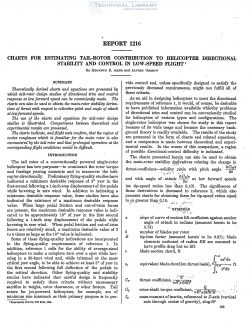naca-report-1216
- Version
- 174 Downloads
- 1.92 MB File Size
- 1 File Count
- November 2, 2016 Create Date
- November 2, 2016 Last Updated
National Advisory Committee for Aeronautics, Report - Charts for Estimating Tail Rotor Contribution to Helicopter Directional Stability and Control in Low Speed Flight

Theoretically derived charts and equations are presented by
which tail-rotor design studies of directional trim and control
response at low forward speed can be conveniently made. The
charts can also be used to obtain the main—rotor stability deriva-
tives of thrust with respect to collective pitch and angle of attack
at low forward speeds.
The use of the charts and equations for tailsotor design
studies is illustrated. Comparisons between theoretical and
experimental results are presented.
The charts indicate, and flight tests confirm, that the region of
sorter roughness which is familiar for the main rotor is also
encountered by the tail rotor and that prolonged operation at the
corresponding flight conditions would be difiicult.
The tail rotor of a conventionally powered single-rotor
helicopter has two purposes—to counteract the rotor torque
and fuselage yawing moments and to maneuver the heli—
copter directionally. Preliminary flying—quality studies have
indicated a minimum desirable response of 3° yaw in the
first second following a 1-inch step displacement of the pedals
while hovering in zero wind. In addition to indicating a
minimum desirable response value, these studies have also;
indicated the existence of a maximum desirable response
value. When large pedal friction ‘and outeof-trim forces
are present, the maximum desirable response value is indi—’
cated to be approximately 10° of yaw in the first second
following a 1-inch step displacement of the pedals while
hovering in zero wind. When pedal friction and out-of—trim
forces are relatively small, a maximum desirable value of 2
to 4 times as large as the 10° value is indicated.
Some of these flying-quality indications are incorporated
in the flying-quality requirements of reference 1. In
addition, reference 1 calls for the ability of average-sized
helicopters to make a complete turn over a spot while hov—
ering in a 30—knot wind and, while trimmed at the most
critical yaw angle, to be able to achieve at least 3° of yaw in
the first second following full deflection of the pedals in
the critical direction. Other flying-quality and stability
studies have indicated that careful design is frequently
required to satisfy these criteria without unnecessary
sacrifice in weight, rotor clearances, or other factors. Tail
rotors for jet-powered helicopters, for example, are of
minimum size inasmuch as their primary purpose is to pro-
vide control and, unless specifically designed to satisfy the
previously discussed requirements, might not fulfill all of
these criteria.
| File | Action |
|---|---|
| naca-report-1216 Charts for Estimating Tail Rotor Contribution to Helicopter Directional Stability and Control in Low Speed Flight.pdf | Download |

Comment On This Post